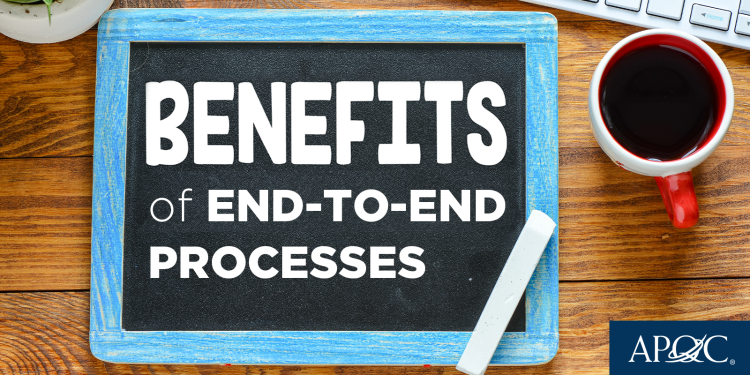
APQC defines end-to-end processes (E2E) as “cross-functional processes that comprise all the steps to accomplish a specific outcome or goal”. Some common workplace examples are order-to-cash, hire-to-retire, and idea-to-market.
Think about the last time you went out to eat at a restaurant. There were many different “functions” that enabled you to have an experience—the host or hostess, the waiter or waitress, the chef, the manager, bartender, and the cleaning crew, just to name a few. All these functions work together with different hand-offs to complete one end-to-end process “Arrive-to-Leave” or in simpler terms, “Eating Out”. It’s important that each function of the Eating Out process communicates with one another and ensures clean hand-offs to avoid errors in the order you receive from the kitchen to your table. This common, and hopefully relatable scenario is essentially an E2E process and will be referenced throughout the blog.
End-to-End Mindset Critical For Organizations
Many managers think about processes in terms of functions, or the events that take place within specific domains they are responsible for. This functional mindset is focused on specialization and requires the ability to execute a set of specific tasks within a linear or job/task process exceptionally well. However, an end-to-end process mindset differs in that it looks at how work occurs across the organization and how well it is handed off between functions.
By revealing how work truly occurs and how processes interact, an end-to-end process mindset allows an organization to:
- better manage for resource optimization,
- focus on the customer experience,
- rationalize investments,
- automate tasks,
- measure overall performance, and
- better coordinate improvement projects.
Benefits of End-to-End Processes
Overall, E2E processes allow organizations to understand what goal they are collectively working towards, i.e. providing a patron with a satisfactory dining experience.
Here’s some examples of E2E benefits and how they relate to the “Eating Out” process:
- A common understanding – all employees at the restaurant understand that patrons come to have a satisfactory dining experience.
- Balanced improvement – when the waiter or waitress understands how best to input meal orders, or customizations to meal orders, it helps the kitchen staff improve their flow and output for the patrons.
- Process interdependencies – the host or hostess activity of “Seating Guests” directly impacts the waiter or waitresses’ activity of “Taking Orders” because if the host puts too many guests under one waiter’s area, that waiter could be overwhelmed, while the other waitress is underwhelmed. It’s important to understand the interdependencies and domino effects of one process to the next.
- Role clarity – each restaurant staff member knows their role and expectations are met – for example the waiter takes the orders while the chef cooks the food; the waiter doesn’t step in to cook and the chef doesn’t step in to take orders. Everyone is clear on their place.
How Does APQC’s PCF Help Define End-to-End Processes?
In order to have successful E2E processes, organizations need to understand how E2Es are created. At a high level, there are four steps:
- Scope and Prioritize
- Identify Stakeholders
- Identify Process Components
- Apply a Lifecycle Approach
Throughout the process of creating E2E processes, organizations will leverage APQC’s Process Classification Framework (PCF)® as an “ingredient list” of process activities to choose from.
In the example below, the PCF categories 3.0, 4.0 and 9.0 were highlighted as relevant. Then in the next image you can see the PCF elements “3.5.4.1 Accept and validate sales order (Take orders)” and “3.5.4.3 Determine availability (Check availability)” are relevant to this end-to-end process. Both elements are the beginning steps of the “Customer Order Process” that can be found in APQC's Order-to-Cash article.
Just like a menu at a restaurant or the ingredient list of a recipe, the PCF serves as a framework or list of process elements for organizations to consider for their end-to-end processes. Learn more here: Creating End-to-End Processes.
Learn More
Join me for my January webinar, 'What Are End-to-End Processes and How Do Organizations Use Them?', where I will discuss items in this blog in more detail as well as cover the challenges of mapping end-to-end processes, explore how organizations use end-to-end processes, and touch on how organizations measure end-to-end processes.
In the interim, check out these APQC collections related to end-to-end processes:
